
Snow Tire Chains Review
When snow and ice make driving difficult, snow tire chains can give you the traction you need to maintain control of your vehicle. The following will give you basic information on using snow tire chains safely.
Basic Guidelines
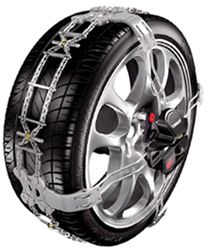
Before Purchasing:
- Check your vehicle owner's manual first to ensure that chains can be used with your vehicle
- Check if you need a limited-clearance snow chain (designated Class "S" by the SAE), because traditional chains might not be recommended for your vehicle. Minimum clearances must be maintained around spring clips, fenders, braces, splash pans, fuel lines, brake lines, brake controls and wherever necessary. The restricted wheel clearances in many downsized and front-wheel drive vehicles may require the use of limited-clearance tire chains or may prohibit their use, as noted in the owner's manual
- Check your state or province laws before using snow chains. Laws regarding snow chain use vary by region
How many sets does my vehicle require?
The basic rule is that snow chains always go on the driving wheels.
- Front Wheel Drive - Place on the 2 front tires
- Rear Wheel Drive - Pickup trucks and older full-sized cars are usually rear-wheeled drive, so chains are placed on rear tires
- 4-Wheel Drive (or All Wheel Drive) - Can use 1 or 2 sets
- With only 1 set of chains, often they are placed on the rear wheels, but they can be used on the front for added steering and braking benefits
Note: For each 3 different drive types, all 4 wheels can be chained to provide extra stability as long as the vehicle's owner manual does not indicate chains cannot be used on all 4 wheels.
Before Using:
- Test your chains to ensure that they fit your tire size before you need to use them in a snow or ice condition
- Keep tire chains snug and tight throughout use. Extra side chain links may be cut off or secured under the side chain or fasteners (for standard snow chains)
During Use
- Accelerate and brake slowly
- Drive approximately a 1/4 mile after installing the chains, then stop and re-tighten the tire chains (for standard snow chains)
- Stay within the snow chain speed limit that is rated for your individual chain set, typically 25-30 mph
- Change your snow chains when the wear of the links is more than 45 percent of the original thickness, so as not to damage the vehicle
- Carry waterproof work gloves, which will give you protection from the cold, but still allow you to install the chains; a flashlight for nighttime and a mat or tarp to protect your clothes
DON'T
- Use tire chains on bare pavement if possible. Chains are ineffective on dry roads and they highly limit the control of the vehicle
- Deflate the tire or use a jack to install or remove the chains
- Leave the vehicle motor running while you are installing or removing tire chains
- Hit curbs with the tire chains installed
- Attempt to use chains that are too large or too small for the tire, because this could result in dangerous driving and damage to the vehicle
- Use as safety chains or as a tow chain
- Spin or lock the wheels
- Continue to drive with a chain that is broken or contacting any part of the vehicle
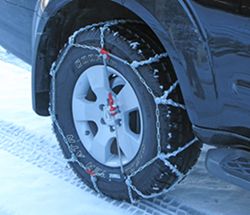
Special Concerns When Using Snow Chains
Mountain Driving
When driving in the mountains, you may be required by law to use snow chains in certain areas. Follow the signs and requirements to avoid difficulty driving.
Emergencies
If a cross chain should break, stop immediately and pull off the road in a safe area away from traffic. Remove or repair the chains, then follow the directions for installing the tire chains. Chains should fit as tightly as possible by hand for maximum chain life.
Tires
Snow chains may cause cosmetic scuffing of tires when installed. This condition is unavoidable with certain tread types and designs. By design, most standard snow tire chains must hang down (drape) the side wall of the tire in order to stay on the tire while being used. As a result, radial tires may also experience some scuffing of the tire's side wall as a result of the flex inherent in the side walls of radial tires.
Wheels
Wheels are also at risk of cosmetic scuffing with the use of snow chains. Larger-diameter wheels that use very low-profile tires, such as 35, 40, 45 and 50 series tires, are especially at risk because of the short height of the tire side wall.
Vehicles
Snow chains can break during the course of their normal service life. They are designed for use in snow or on ice-covered road surfaces - not on bare pavement. Use of chains on bare pavement greatly increases the wear and chance of component failure of the device. Speeds faster than 30 mph also greatly increase the chance of component failure. Continued use of snow chains that have been broken is extremely unsafe and may cause loss of control or damage to the vehicle. Any snow chain that has been broken while in service should be immediately repaired or replaced.
Maintenance
To keep your snow chains in good condition: After removing them, rinse off all road dirt and salt and dry them with a towel. After they are completely dry, store them in your vehicle so you will be ready the next time weather conditions warrant their use.
State and Province Snow Chain Laws
The following state and province snow chain laws are for general reference only and are subject to change. Please consult your individual state or province department of motor vehicles for the most up-to-date snow chain laws.
| State | Law |
|---|---|
| Alabama | Permissible upon any vehicle when required for safety because of snow, rain or other conditions tending to cause a vehicle to slide or skid. |
| Alaska | Permissible when required for safety because of snow, ice or other conditions which may cause a vehicle to skid. Sec. 28.35.155. Operation of vehicle with certain tires prohibited (a) It is unlawful to operate a motor vehicle with studded tires or tires with chains attached on a paved highway or road from May 1 through September 15, inclusive, north of 60 North Latitude and from April 15 through September 30, inclusive, south of 60 North Latitude, except that any latitude on a paved portion of the Sterling Highway, a person may not operate a motor vehicle with studded tires or tires with chains attached from May 1 through September 15, inclusive. |
| Arizona | Permissible when required for safety because of snow, ice or other conditions tending to cause a vehicle to skid. |
| Arkansas | Permissible upon any vehicle when required for safety. |
| California | Required to be equipped with tire traction devices when entering a signed restricted area. |
| Colorado | Signs along the roadway indicate when a vehicle must be chained. The metal chains must consist of two circular metal loops, one on each side of the tire, connected by not less than nine evenly spaced chains across the tire tread. |
| Connecticut | Non-skid devices may be used from Nov. 15 to April 30. |
| Delaware | May be used upon any vehicle when required for safety because of snow, ice or other conditions tending to cause a vehicle to slide or skid. |
| District of Columbia | Permissible when required for safety because of snow, ice or other conditions. |
| Florida | Permissible when required for safety because of snow, ice or other conditions. |
| Georgia | Permissible upon any vehicle when required for safety because of snow, ice or other conditions tending to cause a vehicle to skid. |
| Idaho | Permissible to use tire chains. There are times when chains are required. Signs will be posted "Chains Required Beyond This Point" when the road is snow-covered or icy. |
| Illinois | Permissible upon any vehicle when required for safety because of snow, ice or other conditions tending to cause a vehicle to skid. |
| Indiana | May be used upon a vehicle when required for safety because of snow, ice or other conditions tending to cause a vehicle to skid. |
| Iowa | Permissible upon any vehicle when required for safety because of snow, ice or other conditions tending to cause a vehicle to skid. |
| Kansas | Permissible upon any vehicle when required for safety because of snow, ice or other conditions tending to cause a vehicle to skid. |
| Kentucky | Permissible when icy road conditions exist. |
| Louisiana | Permissible upon any vehicle when required for safety because of conditions tending to cause a vehicle to slide or skid. |
| Maine | Permissible when required for safety because of snow, ice or other conditions. |
| Maryland | Permissible on any vehicle when required for safety because of snow, ice or other conditions tending to cause a vehicle to skid. In case of declared snow emergency, chains will be required on certain designated highways. |
| Massachusetts | They are prohibited w/o a permit from May 1st to Oct 31st but are permitted for use with or without a permit from Nov 1st to May 1st. |
| Michigan | Permissible when snow is on the ground. |
| Minnesota | Permitted when road conditions (ice and snow) require snow tires. |
| Mississippi | Permissible upon any vehicle when required for safety because of snow, ice or other conditions tending to cause a vehicle to skid. |
| Missouri | Permissible when required for safety because of snow, ice or other conditions. |
| Montana | Permissible upon a vehicle when required for safety because of snow, ice or other conditions tending to cause a vehicle to skid. In dangerous or unsafe conditions, the department of transportation may post signs that require vehicles to use chains on driver wheels. |
| Nebraska | Permissible upon any vehicle when required for safety because of snow, ice, or other condition tending to cause a vehicle to slide or skid. |
| Nevada | Roads may be posted with tire chain requirements under certain snow conditions. Vehicles not equipped with chains on at least two driving wheels and at least two braking wheels on each trailer will not be allowed to proceed. |
| New Hampshire | Permissible when required for safety because of snow, ice or other conditions. |
| New Jersey | May be fitted with tire chains of reasonable proportions when roads, streets, and highways are slippery because of rain, snow, ice, oil, manner of construction or other reason; provided, however, that no tire chains shall be used at any time on improved highways when highway conditions do not make such use necessary for the safety of life or property. No person shall use any tire chains so constructed or installed as to be likely to be thrown so as to endanger any person or property. |
| New Mexico | Permissible upon any vehicle when required for safety because of snow, ice or other conditions tending to cause a vehicle to skid. |
| New York | Tire chains are required when a snow emergency has been declared. |
| North Carolina | Permissible upon any vehicle when required for safety because of snow, ice or other conditions tending to cause a vehicle to slide or skid. |
| North Dakota | Permissible to use tire chains. |
| Ohio | Permissible when required for safety because of snow, ice or other conditions. |
| Oklahoma | Permissible upon any vehicle when required for safety because of snow, ice or other conditions tending to cause a vehicle to skid. |
| Oregon | Tire chains are required when conditions demand because of snow, ice or other inclement weather, and signs are posted. |
| Pennsylvania | Required on two tires on a driven axle on emergency routes when the roadway is covered with ice or snow. |
| Rhode Island | Permissible upon any vehicle when required for safety because of snow, ice or other conditions tending to cause a vehicle to skid. |
| South Carolina | Permissible upon any vehicle when required for safety because of snow, ice or other conditions tending to cause a vehicle to skid. |
| South Dakota | Permissible upon any vehicle when required for safety because of snow, ice or other conditions tending to cause a vehicle to slide or skid. The secretary of transportation may restrict public travel upon any state trunk highway system to four-wheel drive vehicles or motor vehicles equipped with tire chains. |
| Tennessee | Permissible to use on any vehicle when required for safety because of snow, ice or other condition tending to cause a vehicle to skid. Must carry one set of tire chains for all vehicles likely to encounter conditions requiring them. |
| Texas | May be used when required for safety because of a condition that might cause the vehicle to skid. |
| Utah | May use on a vehicle when required for safety because of snow, ice or other conditions tending to cause a vehicle to skid. Drivers are advised to carry one set for the drive axle from Nov. 1 to Mar 31. |
| Vermont | Permissible when required for safety because of snow, ice or other conditions. |
| Virginia | Permissible when required for safety because of snow, ice or other conditions tending to cause a vehicle to slide or skid. Vehicles blocking traffic due to lack of tire chains may be fined. |
| Washington | The chain requirements are effective when the department of transportation has posted signs marked "Chains Required." On certain routes sufficient tire chains must always be carried on the vehicle from Nov. 1 to April 1. The number of chains required varies, depending on the number of axles and vehicle configuration. At least two extra chains must be carried on the vehicle. |
| West Virginia | Permissible upon any vehicle when required for safety because of snow, ice or other conditions tending to cause a vehicle to skid. |
| Wisconsin | May be used when required for safety because of snow, ice or other conditions tending to cause a vehicle to skid. |
| Wyoming | May be required when the superintendent or his authorized representative determines that travel is sufficiently hazardous due to snow, ice or other conditions. |
| Province | Law |
| Alberta | Allowed when conditions warrant. |
| British Columbia | Winter tires or chains are required on most routes in British Columbia from October 1 to March 31. For highways, including mountain passes and rural routes in high snowfall areas, the date will be extended until April 30 to account for early-spring snowfall. |
| Manitoba | Permissible upon a motor vehicle where required for safety. |
| New Brunswick | May also be carried in the vehicle for use in ice and snow conditions. |
| Newfoundland | Required on drive wheels when there is snow or ice on the surface of the highway. |
| Nova Scotia | Permissible upon any vehicle when required for safety because of snow, ice or other conditions tending to cause a vehicle to slide or skid. |
| Prince Edward | Permissible to use tire chains. |
| Quebec | The minister of transport may authorize, under the conditions and for the period he determines, the use of certain types of non-skid devices for such road vehicles as he may designate. |
Information courtesy Minnesota Trucking
Updated by: Raymond P.
Last updated: 6/26/18
Departments
Towing
- Trailer Hitch
- Fifth Wheel
- Gooseneck
- Towing a Vehicle
- Front Hitch
- RV Hitch
- ATV Hitch
- HD Truck Hitch
- Vehicle Wiring
- Brake Controller
- Ball Mounts
- Weight Distribution
Sports and Recreation
Trailer Parts
- Utility Trailer
- Boat Trailer
- Landscape Trailer
- Enclosed Trailer
- 5th/Camper Trailer
- Car Hauler
- Horse Trailer
Vehicle
Contact & Help

What our customers are saying:
"This site is top notch: Great prices, great service. Highly recommended."
Popular Vehicles
- Subaru Forester
- Ford F-350 Super Duty
- Ford F-250 Super Duty
- Chevrolet Silverado 1500
- Jeep Wrangler Unlimited
- Jeep Wrangler
- Ram 3500
- Toyota Highlander
- Ram 2500
- Chevrolet Silverado 2500
- Subaru Outback Wagon
- Chevrolet Silverado
- Dodge Ram Pickup
- GMC Sierra 2500
- Ram 1500
- Ford F-250 and F-350 Super Duty
- Jeep Grand Cherokee
- Toyota Tacoma
- GMC Sierra 3500
- Toyota Tundra
- Ford Escape
- More >>


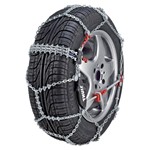













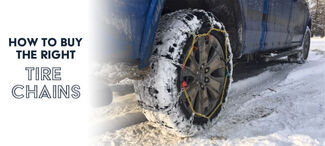





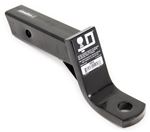





Jb
11/12/2021
Why not use a jack to install or remove the chains? If the car is safely chocked (or the emergency brake applied), it can ease positioning & cinching of the chain around the tire, access to the inside fastener, & inspection of the tension & positioning of the applied chain. "Don't Use as safety chains." What is a 'safety chain' if not a snow or mud tire chain or cable?